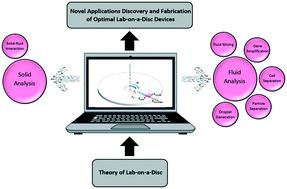Our official English website, www.x-mol.net, welcomes your
feedback! (Note: you will need to create a separate account there.)
Mathematical modeling and computational analysis of centrifugal microfluidic platforms: a review.
Lab on a Chip ( IF 6.1 ) Pub Date : 2020-04-03 , DOI: 10.1039/c9lc00775j Masoud Madadelahi 1 , Luis F Acosta-Soto , Samira Hosseini , Sergio O Martinez-Chapa , Marc J Madou
Lab on a Chip ( IF 6.1 ) Pub Date : 2020-04-03 , DOI: 10.1039/c9lc00775j Masoud Madadelahi 1 , Luis F Acosta-Soto , Samira Hosseini , Sergio O Martinez-Chapa , Marc J Madou
Affiliation

|
Centrifugal microfluidic platforms or lab-on-discs (LODs) have evolved into a popular technology for automating chemical and biological assays. LODs today enable scientists to implement and integrate different operational units, including fluid mixing, droplet generation, cell-sorting, gene amplification, analyte detection, and so forth. For an efficient design and cost-effective implementation of any microfluidic device, including LODs, theoretical analysis and considerations should play a more important role than they currently do. The theoretical analysis we will show is especially essential to the investigation of detailed phenomena at the small length scales and high-speed typical for LODs where a wide range of forces may be involved. Previous LOD review papers presented mostly experimental results with theory as an afterthought. Hence, a review paper focused on the theoretical aspects, and associated computational studies of LOD devices is an urgent need. In the present review paper, all previous computational studies on LOD devices are categorized as single-phase flows, two-phase flows, network simulation, and solids. For each of these categories, the governing equations and important formulas are presented and explained. Moreover, a handy scaling analysis is introduced to aid scientists when comparing different competing forces in LOD devices. We hope that by surveying and contrasting various theoretical LOD studies, we shed some light on existing controversies and reveal where additional theoretical work is needed.
中文翻译:

离心微流控平台的数学建模和计算分析:综述。
离心微流控平台或盘上实验室(LOD)已经发展成为一种用于自动化化学和生物学测定的流行技术。如今,LOD使科学家能够实施和整合不同的操作单元,包括流体混合,液滴生成,细胞分选,基因扩增,分析物检测等。为了有效设计和以经济高效的方式实现任何微流体设备(包括LOD),理论分析和考虑因素应比目前发挥更重要的作用。我们将展示的理论分析对于研究可能涉及范围广泛的力的LOD典型的小长度尺度和高速下的详细现象尤为重要。先前的LOD审查论文主要是将实验结果与理论联系在一起。因此,一篇针对理论方面的综述论文以及相关的LOD设备计算研究是迫切需要的。在本篇综述文件中,以前对LOD设备进行的所有计算研究都分为单相流,两相流,网络模拟和固体。对于这些类别中的每一个类别,都会给出并解释控制方程式和重要公式。此外,在比较LOD设备中的不同竞争力时,引入了方便的缩放分析以帮助科学家。我们希望通过调查和对比各种理论上的LOD研究,我们可以对现有争议有所了解,并揭示在哪些地方需要进行其他理论研究。以前有关LOD设备的所有计算研究都分为单相流,两相流,网络模拟和固体。对于这些类别中的每一个类别,都会给出并解释控制方程式和重要公式。此外,在比较LOD设备中的不同竞争力时,引入了方便的缩放分析以帮助科学家。我们希望通过调查和对比各种理论上的LOD研究,我们可以对现有争议有所了解,并揭示在哪些地方需要进行其他理论研究。以前有关LOD设备的所有计算研究都分为单相流,两相流,网络模拟和固体。对于这些类别中的每一个类别,都会给出并解释控制方程式和重要公式。此外,在比较LOD设备中的不同竞争力时,引入了方便的缩放分析以帮助科学家。我们希望通过调查和对比各种理论上的LOD研究,我们可以对现有争议有所了解,并揭示在哪些地方需要进行其他理论研究。在比较LOD设备中的不同竞争力时,引入了方便的缩放分析,以帮助科学家。我们希望通过调查和对比各种理论上的LOD研究,我们可以对现有争议有所了解,并揭示在哪些地方需要进行其他理论研究。在比较LOD设备中的不同竞争力时,引入了方便的缩放分析,以帮助科学家。我们希望通过调查和对比各种理论上的LOD研究,我们可以对现有争议有所了解,并揭示在哪些地方需要进行其他理论研究。
更新日期:2020-04-24
中文翻译:

离心微流控平台的数学建模和计算分析:综述。
离心微流控平台或盘上实验室(LOD)已经发展成为一种用于自动化化学和生物学测定的流行技术。如今,LOD使科学家能够实施和整合不同的操作单元,包括流体混合,液滴生成,细胞分选,基因扩增,分析物检测等。为了有效设计和以经济高效的方式实现任何微流体设备(包括LOD),理论分析和考虑因素应比目前发挥更重要的作用。我们将展示的理论分析对于研究可能涉及范围广泛的力的LOD典型的小长度尺度和高速下的详细现象尤为重要。先前的LOD审查论文主要是将实验结果与理论联系在一起。因此,一篇针对理论方面的综述论文以及相关的LOD设备计算研究是迫切需要的。在本篇综述文件中,以前对LOD设备进行的所有计算研究都分为单相流,两相流,网络模拟和固体。对于这些类别中的每一个类别,都会给出并解释控制方程式和重要公式。此外,在比较LOD设备中的不同竞争力时,引入了方便的缩放分析以帮助科学家。我们希望通过调查和对比各种理论上的LOD研究,我们可以对现有争议有所了解,并揭示在哪些地方需要进行其他理论研究。以前有关LOD设备的所有计算研究都分为单相流,两相流,网络模拟和固体。对于这些类别中的每一个类别,都会给出并解释控制方程式和重要公式。此外,在比较LOD设备中的不同竞争力时,引入了方便的缩放分析以帮助科学家。我们希望通过调查和对比各种理论上的LOD研究,我们可以对现有争议有所了解,并揭示在哪些地方需要进行其他理论研究。以前有关LOD设备的所有计算研究都分为单相流,两相流,网络模拟和固体。对于这些类别中的每一个类别,都会给出并解释控制方程式和重要公式。此外,在比较LOD设备中的不同竞争力时,引入了方便的缩放分析以帮助科学家。我们希望通过调查和对比各种理论上的LOD研究,我们可以对现有争议有所了解,并揭示在哪些地方需要进行其他理论研究。在比较LOD设备中的不同竞争力时,引入了方便的缩放分析,以帮助科学家。我们希望通过调查和对比各种理论上的LOD研究,我们可以对现有争议有所了解,并揭示在哪些地方需要进行其他理论研究。在比较LOD设备中的不同竞争力时,引入了方便的缩放分析,以帮助科学家。我们希望通过调查和对比各种理论上的LOD研究,我们可以对现有争议有所了解,并揭示在哪些地方需要进行其他理论研究。











































 京公网安备 11010802027423号
京公网安备 11010802027423号